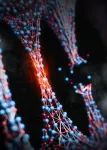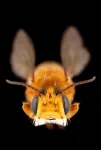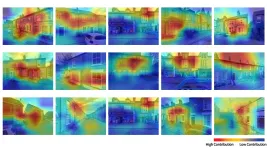(Press-News.org) Researchers at Delft University of Technology, led by assistant professor Richard Norte, have unveiled a remarkable new material with potential to impact the world of material science: amorphous silicon carbide (a-SiC). Beyond its exceptional strength, this material demonstrates mechanical properties crucial for vibration isolation on a microchip. Amorphous silicon carbide is therefore particularly suitable for making ultra-sensitive microchip sensors.
The range of potential applications is vast. From ultra-sensitive microchip sensors and advanced solar cells, to pioneering space exploration and DNA sequencing technologies. The advantages of this material's strength combined with its scalability make it exceptionally promising.
Ten medium-sized cars
“To better understand the crucial characteristic of "amorphous", think of most materials as being made up of atoms arranged in a regular pattern, like an intricately built Lego tower,” explains Norte. “These are termed as "crystalline" materials, like for example, a diamond. It has carbon atoms perfectly aligned, contributing to its famed hardness.” However, amorphous materials are akin to a randomly piled set of Legos, where atoms lack consistent arrangement. But contrary to expectations, this randomisation doesn't result in fragility. In fact, amorphous silicon carbide is a testament to strength emerging from such randomness.
The tensile strength of this new material is 10 GigaPascal (GPa). “To grasp what this means, imagine trying to stretch a piece of duct tape until it breaks. Now if you’d want to simulate the tensile stress equivalent to 10 GPa, you'd need to hang about ten medium-sized cars end-to-end off that strip before it breaks,” says Norte.
Nanostrings
The researchers adopted an innovative method to test this material's tensile strength. Instead of traditional methods that might introduce inaccuracies from the way the material is anchored, they turned to microchip technology. By growing the films of amorphous silicon carbide on a silicon substrate and suspending them, they leveraged the geometry of the nanostrings to induce high tensile forces. By fabricating many such structures with increasing tensile forces, they meticulously observed the point of breakage. This microchip-based approach not only ensures unprecedented precision but also paves the way for future material testing.
Why the focus on nanostrings? “Nanostrings are fundamental building blocks, the very foundation that can be used to construct more intricate suspended structures. Demonstrating high yield strength in a nanostring translates to showcasing strength in its most elemental form.”
From micro to macro
And what finally sets this material apart is its scalability. Graphene, a single layer of carbon atoms, is known for its impressive strength but is challenging to produce in large quantities. Diamonds, though immensely strong, are either rare in nature or costly to synthesize. Amorphous silicon carbide, on the other hand, can be produced at wafer scales, offering large sheets of this incredibly robust material.
“With amorphous silicon carbide's emergence, we're poised at the threshold of microchip research brimming with technological possibilities,” concludes Norte.
END
TU Delft researchers discover new ultra strong material for microchip sensors
A material that doesn't just rival the strength of diamonds and graphene, but boasts a yield strength 10 times greater than Kevlar, renowned for its use in bulletproof vests
2023-11-02
ELSE PRESS RELEASES FROM THIS DATE:
Buzz around new centralized pollination portal for better global bee data
2023-11-02
A powerful new way to fill major gaps in public bee data – including from Africa, Asia and other under-reported zones – has been addressed with a centralised tool for consolidating bee pollinator occurrences around the globe.
Called BeeBCD, the package outlined in a new Nature journal article, brings together more than 18 million bee occurrence records from multiple public and private databases to improve accuracy and accessibility of species data from around the world for future conservation, research and farming management.
The rationalised bee occurrence datasets will help support future plant and crop production ...
What a “2D” quantum superfluid feels like to the touch
2023-11-02
Researchers from Lancaster University in the UK have discovered how superfluid helium 3He would feel if you could put your hand into it.
The interface between the exotic world of quantum physics and classical physics of the human experience is one of the major open problems in modern physics.
Dr Samuli Autti is the lead author of the research published in Nature Communications.
Dr Autti said: “In practical terms, we don’t know the answer to the question ‘how does it feel to touch quantum physics?’
“These experimental conditions are extreme and the techniques complicated, but I can now tell ...
NIH grants support UCLA and Charles Drew University researchers' efforts to end HIV epidemic
2023-11-02
NIH grants support UCLA and Charles Drew University researchers' efforts to end HIV epidemic
The National Institutes of Health (NIH) has granted $2.1 million to UCLA’s Center for HIV Identification, Prevention, and Treatment Services (CHIPTS) and the UCLA-CDU Center for AIDS Research (CFAR) to support four research projects and an implementation science consultation hub. These awards will fund projects to strengthen research-community collaborations and enhance implementation strategies needed for the Ending the HIV Epidemic in the U.S. (EHE) initiative.
“These awards will support our scientists and ...
AI trained to identify least green homes by Cambridge researchers
2023-11-02
University of Cambridge media release
First of its kind AI-model can help policy-makers efficiently identify and prioritize houses for retrofitting and other decarbonizing measures.
FOR IMMEDIATE RELEASE
Model identified ‘hard to decarbonize’ houses with 90% precision and additional data will improve this.
Model trained with open source data including from energy performance certificates, and street and aerial view images. It could be used anywhere in the world.
Model can even identify specific parts of houses losing most heat, including roofs and windows.
‘Hard-to-decarbonize’ (HtD) houses are responsible ...
EU MiFID II unbundling rules damaged research and liquidity in London’s main stock market – new study
2023-11-02
New research from the University of Bath shows the European Union’s MiFID II financial market reforms inadvertently reduced research activity and adversely affected liquidity in London’s main stock market but that the impact on London’s less regulated Alternative Investment Market was mitigated by its special adviser rules.
The EU’s Markets in Financial Instruments Directive II (MiFID II) from 2018 aimed to improve transparency around research costs, which were previously bundled into brokers’ overall fees to clients. The legislation demanded the fees be ‘unbundled’ to make the hidden costs more explicit ...
International study led by researchers in Singapore reveals critical insights into timely interventions for maternal depression
2023-11-02
SINGAPORE – A large-scale international study spanning three continents, led by researchers from A*STAR’s Translational Neuroscience Programme of the Singapore Institute for Clinical Sciences (SICS) in Singapore, has found that maternal depressive symptoms begin from early pregnancy and can last up to two years after childbirth.
While health professionals often emphasise the postpartum stage after childbirth as a high-risk period for the onset of depression, findings from this latest study reveal a different reality – that maternal depressive symptoms can appear from early pregnancy ...
Paper argues reducing greenhouse gas emissions is not enough to combat climate change
2023-11-02
According to a new paper in Oxford Open Climate Change, published by Oxford University Press, the strategies humanity must pursue to reduce climate change will have to include more than reducing greenhouse gases. This comes from an analysis of climate data led by researcher James Hansen.
Scientists have known since the 1800s that infrared-absorbing (greenhouse) gases warm the Earth’s surface and that the abundance of greenhouse gases changes naturally as well as from human actions. Roger Revelle, who was one of the early scientists to study global warming, wrote in 1965 that industrialization meant that human ...
Research examines why mask usage in Japan persists
2023-11-02
Osaka, Japan – When you think of Japan in the age of COVID, you might imagine a crowd of people wearing masks. But why do so many Japanese people wear masks?
In an article published this month in the International Journal of Disaster Risk Reduction, a researcher from Osaka University analyzed mask use before and after the government of Japan downgraded the legal status of COVID-19. Results showed that many people continue to wear masks for socio-psychological reasons – including reasons related to ‘relief’ and ‘norm’.
Of course, the obvious motivation for mask use is disease prevention. In the first ...
Exercise therapy based on smart data to improve patients' quality of life
2023-11-02
Regular and moderate physical activity can significantly improve the quality of life of people with internal diseases such as cancer and depression. Unfortunately, many people with internal disorders cannot sufficiently participate in exercise training for several reasons. For example, they often do not have access to appropriate exercise training programs, have a high therapeutic burden, fatigue, or simply no time to engage in physical activity. Accordingly, the Sports Medicine research group led by Professor Perikles Simon at Johannes Gutenberg University Mainz (JGU) investigates how physical activity can be promoted and integrated into patients' daily lives by applying digital tools ...
Alternative antibiotic selection can reduce the risk of healthcare-associated infections for patients with pneumonia
2023-11-02
Arlington, Va. — November 2, 2023 — A new study published today in the American Journal of Infection Control (AJIC) reveals that the use of doxycycline may help protect against Clostridioides difficile (C. diff) infection for some patients with pneumonia. Specifically, study authors found that for hospitalized patients with community-acquired pneumonia who had experienced C. diff infections in the prior year, the use of doxycycline, instead of the more commonly used azithromycin, reduced the development ...
LAST 30 PRESS RELEASES:
Numbers in our sights affect how we perceive space
SIMJ announces global collaborative book project in commemoration of its 75th anniversary
Air pollution exposure and birth weight
Obstructive sleep apnea risk and mental health conditions among older adults
How talking slows eye movements behind the wheel
The Ceramic Society of Japan’s Oxoate Ceramics Research Association launches new international book project
Heart-brain connection: international study reveals the role of the vagus nerve in keeping the heart young
Researchers identify Rb1 as a predictive biomarker for a new therapeutic strategy in some breast cancers
Survey reveals ethical gaps slowing AI adoption in pediatric surgery
Stimulant ADHD medications work differently than thought
AI overestimates how smart people are, according to HSE economists
HSE researchers create genome-wide map of quadruplexes
Scientists boost cell "powerhouses" to burn more calories
Automatic label checking: The missing step in making reliable medical AI
Low daily alcohol intake linked to 50% heightened mouth cancer risk in India
American Meteorological Society announces Rick Spinrad as 2026 President-Elect
Biomass-based carbon capture spotlighted in newly released global climate webinar recording
Illuminating invisible nano pollutants: advanced bioimaging tracks the full journey of emerging nanoscale contaminants in living systems
How does age affect recovery from spinal cord injury?
Novel AI tool offers prognosis for patients with head and neck cancer
Fathers’ microplastic exposure tied to their children’s metabolic problems
Research validates laboratory model for studying high-grade serous ovarian cancer
SIR 2026 delivers transformative breakthroughs in minimally invasive medicine to improve patient care
Stem Cell Reports most downloaded papers of 2025 highlight the breadth and impact of stem cell research
Oxford-led study estimates NHS spends around 3% of its primary and secondary care budget on the health impacts of heat and cold in England
A researcher’s long quest leads to a smart composite breakthrough
Urban wild bees act as “microbial sensors” of city health.
New study finds where you live affects recovery after a hip fracture
Forecasting the impact of fully automated vehicle adoption on US road traffic injuries
Alcohol-related hospitalizations from 2016 to 2022
[Press-News.org] TU Delft researchers discover new ultra strong material for microchip sensorsA material that doesn't just rival the strength of diamonds and graphene, but boasts a yield strength 10 times greater than Kevlar, renowned for its use in bulletproof vests





